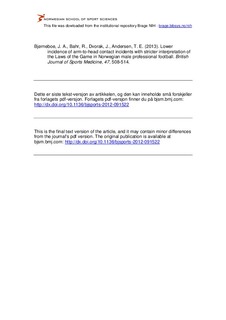| dc.contributor.author | Bjørneboe, John | |
| dc.contributor.author | Bahr, Roald | |
| dc.contributor.author | Dvorak, Jiri | |
| dc.contributor.author | Andersen, Thor Einar | |
| dc.date.accessioned | 2013-10-18T13:19:19Z | |
| dc.date.available | 2013-10-18T13:19:19Z | |
| dc.date.issued | 2013-01-11 | |
| dc.identifier | Seksjon for idrettsmedisinske fag / Department of Sports Medicine | |
| dc.identifier.citation | British Journal of Sports Medicine. 2013, 47, 508-514 | no_NO |
| dc.identifier.uri | http://hdl.handle.net/11250/170940 | |
| dc.description | I Brage finner du siste tekst-versjon av artikkelen, og den kan inneholde ubetydelige forskjeller fra forlagets pdf-versjon. Forlagets pdf-versjon finner du på bjsm.bmj.com: http://dx.doi.org/10.1136/bjsports-2012-091522 / In Brage you'll find the final text version of the article, and it may contain insignificant differences from the journal's pdf version. The definitive version is available at bjsm.bmj.com: http://dx.doi.org/10.1136/bjsports-2012-091522 | no_NO |
| dc.description.abstract | Background Video analyses reveal that the rate of incidents with a propensity for injury caused by opponent-to-player contact has increased by about 50% from 2000 to 2010 in Norwegian male professional football. The aim of the study was to assess whether a stricter interpretation of the Laws of the Game (red cards for high elbows in heading duels and for late/two foot tackles) could reduce the potential for injuries in Norwegian male professional football.
Methods A preintervention/postintervention design was employed, where the rate of incidents and injuries from the 2010 season (pre) was compared to the 2011 season (post). An incident was recorded if the match was interrupted by the referee, and the player lay down for more than 15 s, and appeared to be in pain or received medical treatment. Time-loss injuries were recorded by the medical staff of each club.
Results A total of 1421 contact incidents were identified, corresponding to a rate of 92.7 (95% CI 86.0 to 99.4) in the 2010 season and 86.6 (95% CI 80.3 to 99.4) in the 2011 season, with no difference between the two season. We found a reduction in the incidence of total head incidents (rate ratio (RR) 0.81, 95% CI 0.67 to 0.99), and head-incidents caused by arm-to-head contact (RR 0.72, 95% CI 0.54 to 0.97). We found no difference in tackling characteristics or contact injury rate.
Conclusions We found no significant differences in the overall rate of incidents after the introduction of stricter rule enforcement. However, the rate of head and arm-to head incidents was lower in the 2011 season. | no_NO |
| dc.language.iso | eng | no_NO |
| dc.publisher | BMJ Publishing | no_NO |
| dc.subject | arm | |
| dc.subject | craniocerebral trauma / epidemiology, prevention & control | |
| dc.subject | head | |
| dc.subject | incidence | |
| dc.subject | male | |
| dc.subject | Norway / epidemiology | |
| dc.subject | prospective studies | |
| dc.subject | soccer / injuries, legislation & jurisprudence | |
| dc.subject | videotape recording | |
| dc.title | Lower incidence of arm-to-head contact incidents with stricter interpretation of the Laws of the Game in Norwegian male professional football | no_NO |
| dc.type | Journal article | no_NO |
| dc.type | Peer reviewed | no_NO |
| dc.subject.nsi | VDP::Social science: 200::Social science in sports: 330::Other subjects within physical education: 339 | no_NO |
| dc.source.journal | British Journal of Sports Medicine | no_NO |
| dc.identifier.doi | 10.1136/bjsports-2012-091522 | |
